Silicate Sawing Sludge Recovery in Thermo Eco-Mortar for Macroporous Plaster
Abstract
1. Introduction
2. Materials and Methods
2.1. Mix Design Components Characterisation
- waste after flaming used as a sand aggregate.
- waste from sawing blocks into slabs through diamond tools, used as a filler aggregate.
2.2. Plaster Mix Design
2.3. Physical Properties
2.3.1. Bulk Density
2.3.2. Spreading Test
2.3.3. Thermal Conductivity
2.3.4. Water Absorption
2.4. Mechanical Properties
2.4.1. Flexural Strength
2.4.2. Compressive Strength
2.4.3. Pull out
2.5. Chemical Properties
2.5.1. Resistance to Salt Crystallisation
2.5.2. Chemical Analysis and Leaching Test
3. Results and Discussion
3.1. Physical Properties
3.2. Mechanical Properties
3.3. Chemical Properties
3.3.1. Salt Crystallisation Resistance
3.3.2. Chemical Analysis and Leaching Test
4. Conclusions
Author Contributions
Funding
Acknowledgments
Conflicts of Interest
References
- Garbarino, E.; Orveillon, G.; Saveyn, H.G.; Barthe, P.; Eder, P. Best available technique (BAT) Reference document for the management of waste from extractive industries; JRC Science for policy Report; Publications Office of the EuropeanUnion: Luxembourg, 2018. [Google Scholar]
- Directive, E.C. Directive 2008/98/EC-of the European Parliament and of the Council of 19 November 2008 on waste and repealing certain directives. Off. J. Eur. Union L 2008, 312, 3. [Google Scholar]
- Available online: http://www.arpa.piemonte.it/reporting/indicatori-on_line/uso-delle-risorse/industria/industria_cave-e-miniere-1 (accessed on 11 March 2020).
- Yen, C.L.; Tseng, D.H.; Lin, T.T. Characterisation of eco-cement paste produced from waste sludges. Chemosphere 2011, 84, 220–226. [Google Scholar] [CrossRef] [PubMed]
- Khodabakhshian, A.; De Brito, J.; Ghalehnovi, M.; Shamsabadi, E.A. Mechanical, environmental and economic performance of structural concrete containing silica fume and marble industry waste powder. Constr. Build. Mater. 2018, 169, 237–251. [Google Scholar] [CrossRef]
- Singh, M.; Choudhary, K.; Srivastava, A.; Sangwan, K.S.; Bhunia, D. A study on environmental and economic impacts of using waste marble powder in concrete. J. Build. Eng. 2017, 13, 87–95. [Google Scholar] [CrossRef]
- Dos Santos Vazzoler, J.; Vieira, G.L.; Teles, C.R.; Degen, M.K.; Teixeira, R.A. Investigation of the potential use of waste from ornamental stone processing after heat treatment for the production of cement-based paste. Constr. Build. Mater. 2018, 177, 314–321. [Google Scholar] [CrossRef]
- Scrivener, K.L.; John, V.M.; Gartner, E.M. Eco-efficient cements: Potential economically viable solutions for a low-CO2 cement-based materials industry. Cem. Concr. Res. 2018, 114, 2–26. [Google Scholar] [CrossRef]
- Pierucci, A.; De Tommasi, G.; Calabrese, D.; Petrella, A.; Petrella, M. Reuse of limestone cutting waste in the production of mortars and plasters for building restoration. In Proceedings of the Valorisation and Recycling of Industrial Waste—VI International Congress, L’Aquila, Italy, 27–29 June 2007. [Google Scholar] [CrossRef]
- Mashaly, A.O.; Shalaby, B.N.; Rashwan, M.A. Performance of mortar and concrete incorporating granite sludge as cement replacement. Constr. Build. Mater. 2018, 169, 800–818. [Google Scholar] [CrossRef]
- Al-Hamaiedeh, H.D.; Khushefati, W.H. Granite sludge reuse in mortar and concrete. J. Appl. Sci. 2013, 13, 444–450. [Google Scholar] [CrossRef]
- Sharma, N.K.; Kumar, P.; Kumar, S.; Thomas, B.S.; Gupta, R.C. Properties of concrete containing polished granite waste as partial substitution of coarse aggregate. Constr. Build. Mater. 2017, 151, 158–163. [Google Scholar] [CrossRef]
- Lokeshwari, M.; Jagadish, K.S. Eco-friendly use of granite fines waste in building blocks. Procedia Environ. Sci. 2016, 35, 618–623. [Google Scholar] [CrossRef]
- Ramos, T.; Matos, A.M.; Schmidt, B.; Rio, J.; Sousa-Coutinho, J. Granitic quarry sludge waste in mortar: Effect on strength and durability. Constr. Build. Mater. 2013, 47, 1001–1009. [Google Scholar] [CrossRef]
- Ghannam, S.; Najm, H.; Vasconez, R. Experimental study of concrete made with granite and iron powders as partial replacement of sand. Sustain. Mater. Technol. 2016, 9, 1–9. [Google Scholar] [CrossRef]
- Mármol, I.; Ballester, P.; Cerro, S.; Monrós, G.; Morales, J.; Sánchez, L. Use of granite sludge wastes for the production of coloured cement-based mortars. Cem. Concr. Compos. 2010, 32, 617–622. [Google Scholar] [CrossRef]
- Singh, S.; Nagar, R.; Agrawal, V. A review on properties of sustainable concrete using granite dust as replacement for river sand. J. Clean. Product. 2016, 126, 74–87. [Google Scholar] [CrossRef]
- EN 933 part 1: (2012). Tests to Determine the Geometrical Characteristics of the Aggregates—Part 1: Determination of the Particle Size Distribution—Particle Size Analysis by Sieving; Comite Europeen de Normalisation: Brussel, Belgium, 2012. [Google Scholar]
- Legislative Decree 3 April 2006, n. 152. “Environmental Regulations”. Published in the Official Gazette n. 88 of April 14th, 2006—Ordinary Supplement n. 96. Available online: https://www.camera.it/parlam/leggi/deleghe/06152dl.htm (accessed on 11 March 2020).
- EN 12457-2 (2004). Waste Characterisation–Leaching–Compliance Test for Leaching of Granular and Sludge Waste—Part 2: Single Stage Test, with a Liquid/Solid Ratio of 10 L/kg, for Materials with Particles Smaller than 4 mm (with or without Size Reduction); Comite Europeen de Normalisation: Brussel, Belgium, 2004. [Google Scholar]
- UNI 10802: (2013). Waste-Manual Sampling, Sample Preparation and Eluate Analysis; UNI: Milan, Italy, 2013. [Google Scholar]
- Akthar, F.K.; Evans, J.R.G. High porosity (>90%) cementitious foams. Cem. Concr. Res. 2010, 40, 352–358. [Google Scholar] [CrossRef]
- De Gennaro, R.; Langella, A.; D’Amore, M.; Dondi, M.; Colella, A.; Cappelletti, P.; de Gennaro, M. Use of zeolite-rich rocks and waste materials for the production of structural lightweight concretes. Appl. Clay Sci. 2008, 41, 61–72. [Google Scholar] [CrossRef]
- Napolano, L.; Menna, C.; Graziano, S.F.; Asprone, D.; D’Amore, M.; de Gennaro, R.; Dondi, M. Environmental life cycle assessment of lightweight concrete to support recycled materials selection for sustainable design. Constr. Build. Mater. 2016, 119, 370–384. [Google Scholar] [CrossRef]
- Collepardi, M. La lezione dei romani: Durabilità e sostenibilità delle opere architettoniche e strutturali. Proceedings of III Convegno AIMAT “Restauro e Conservazione dei Beni Culturali: Materiali e Tecniche”, Cassino, Italy, 3–4 October 2003. [Google Scholar]
- Collepardi, M.; Collepardi, S.; Troli, R. Il Nuovo Calcestruzzo—Enco S.r.l.; Ponzano Veneto, Grafiche Tintoretto, Ed: Villorba, Italy, 2009. [Google Scholar]
- EN 1015-6: (2007). Test methods for Mortar for Masonry Work—Part 6: Determination of the Apparent Density of Fresh Mortar; Comite Europeen de Normalisation: Brussel, Belgium, 2007. [Google Scholar]
- EN 1015-10: (2007). Test Methods for Mortar for Masonry Work—Part 10: Determination of the Apparent Density of the Dried Hardened Mortar; Comite Europeen de Normalisation: Brussel, Belgium, 2007. [Google Scholar]
- EN 1015-11: (2007). Test Methods for Mortar for Masonry Work—Part 11: Determination of Flexural and Compressive Strength of Hardened Mortar; Comite Europeen de Normalisation: Brussel, Belgium, 2007. [Google Scholar]
- EN 12371: (2010). Test Method for Natural Stones—Determination of Frost Resistance; Comite Europeen de Normalisation: Brussel, Belgium, 2010. [Google Scholar]
- EN 1015-12: (2016). Test Methods for Mortar for Masonry Work—Part 12: Determination of Adherence to the Support of External and Internal Plaster Mortars; Comite Europeen de Normalisation: Brussel, Belgium, 2016. [Google Scholar]
- EN 998-1: (2016). Specification for Mortar for Masonry Work—Part 1: Mortars for Internal and External Plasters; Comite Europeen de Normalisation: Brussel, Belgium, 2016. [Google Scholar]
- EN 998-2: (2016). Specification for Mortar for Masonry Work—Part 2: Masonry Mortars; Comite Europeen de Normalisation: Brussel, Belgium, 2016. [Google Scholar]
- ASTM D 6103 (2017). Standard Test Method for Flow Consistency of Controlled Low Strength Material (CLSM); American Society for Testing and Materials: Conshohocken, PA, USA, 2017. [Google Scholar]
- EN 13755:2008. Test Methods for Natural Stones—Determination of Water Absorption at Atmospheric Pressure; Comite Europeen de Normalisation: Brussel, Belgium, 2008. [Google Scholar]
- EN 1745: (2012). Masonry and Masonry Products—Methods for Determining Thermal Properties; Comite Europeen de Normalisation: Brussel, Belgium, 2012. [Google Scholar]
- EN 12370: (2001). Test Methods for Natural Stones—Determination of Resistance to Crystallization of Salts; Comite Europeen de Normalisation: Brussel, Belgium, 2001. [Google Scholar]
- Available online: https://www.indexspa.it/indexspacom/TECNOPLAN/pdf/POROVENT_SYSTEM-EN.pdf (accessed on 11 March 2020).
- Available online: https://www.vimark.com/wp-content/uploads/2016/02/MURDRY_0116_ENG.pdf (accessed on 11 March 2020).
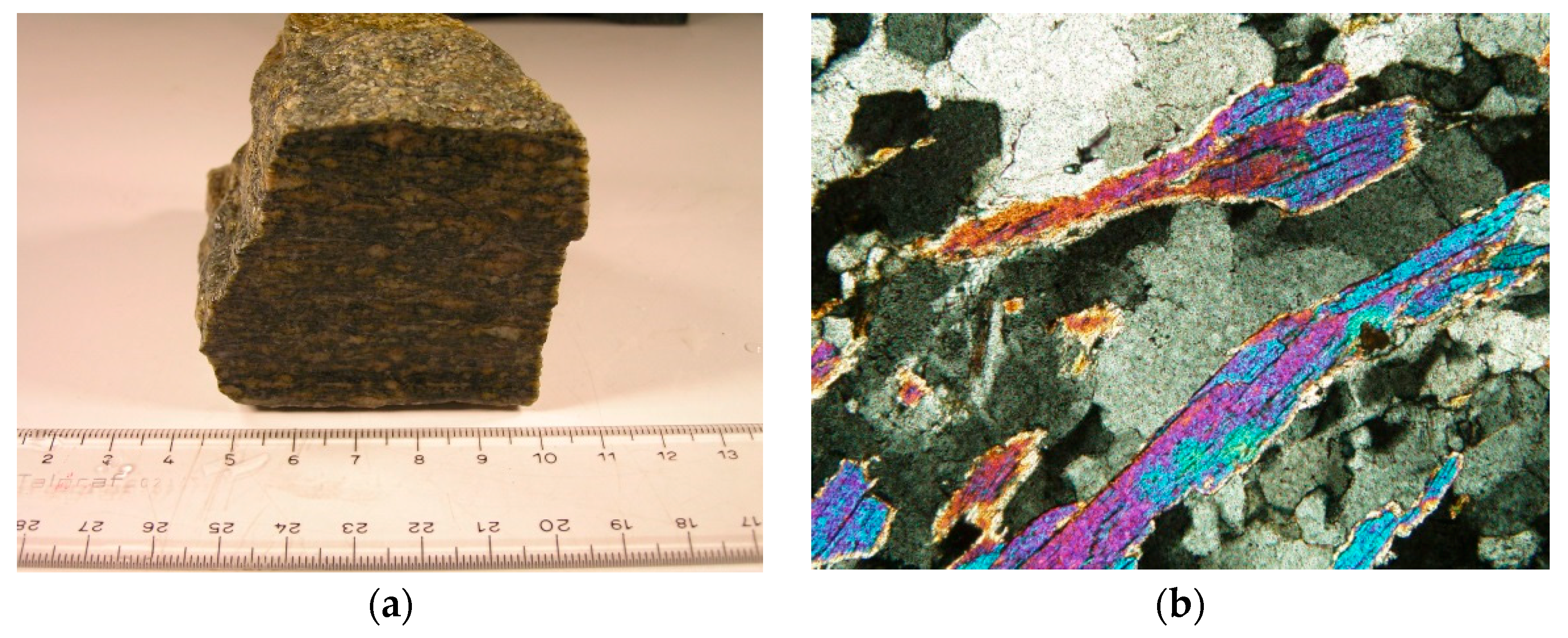
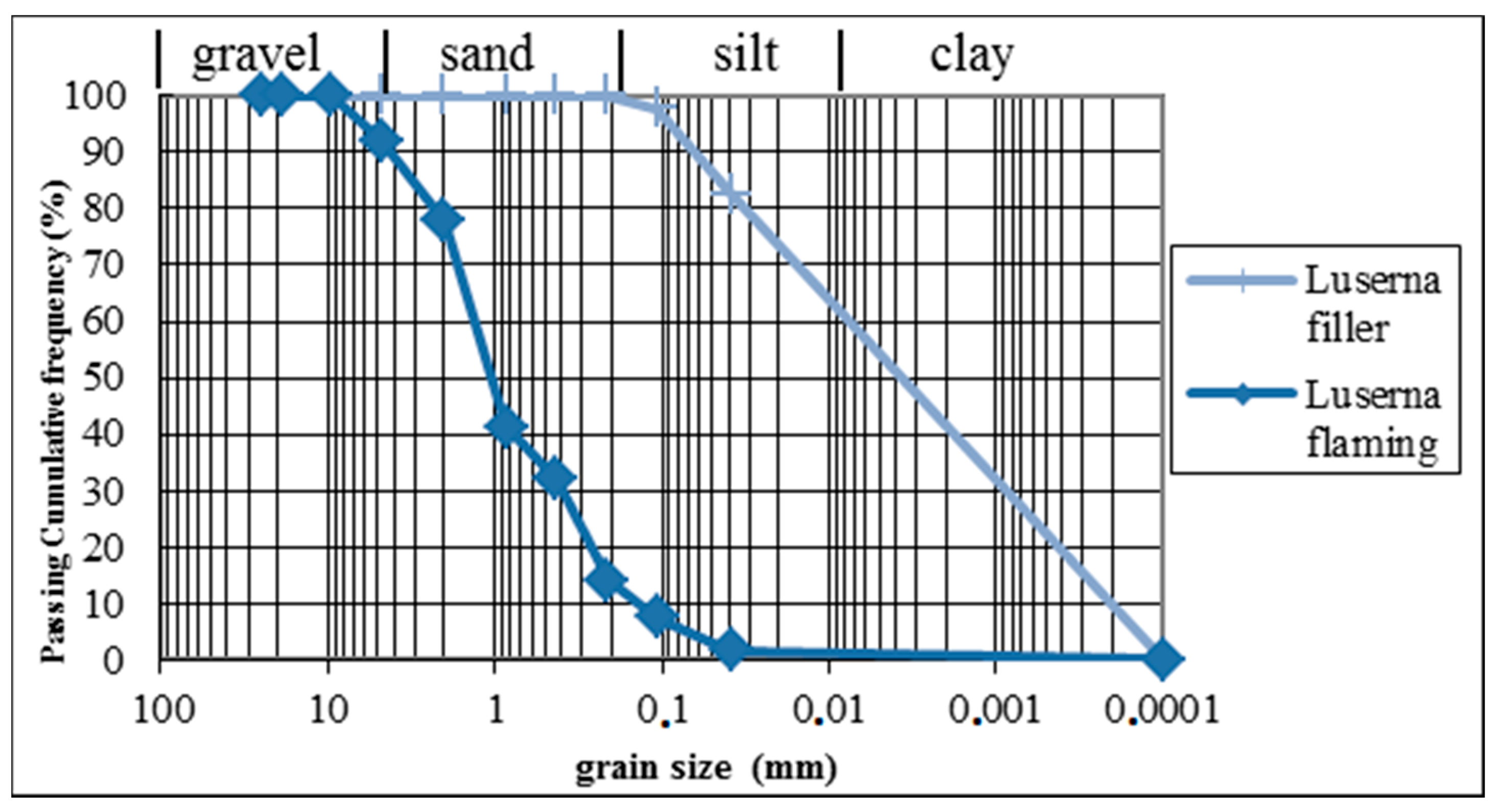
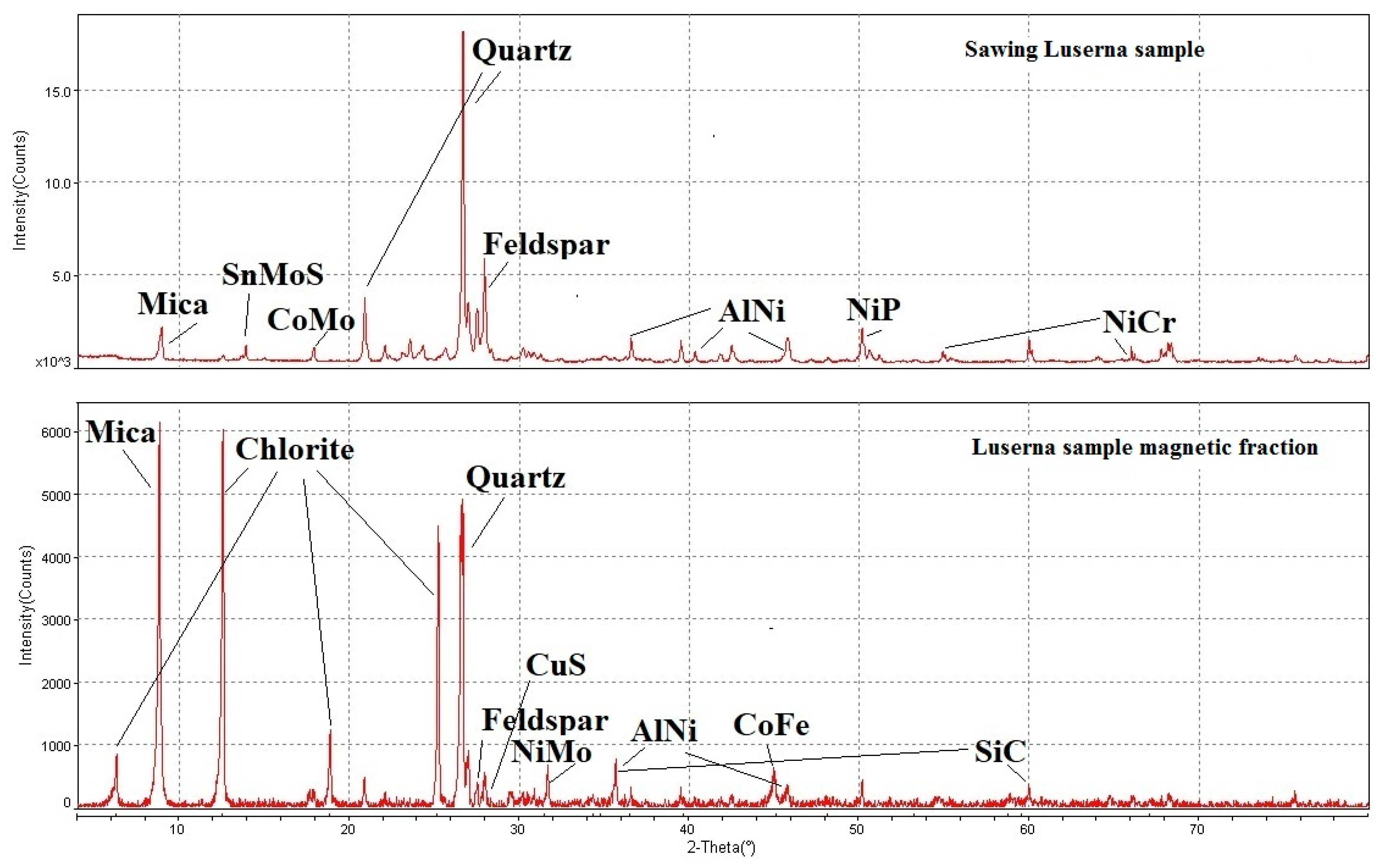
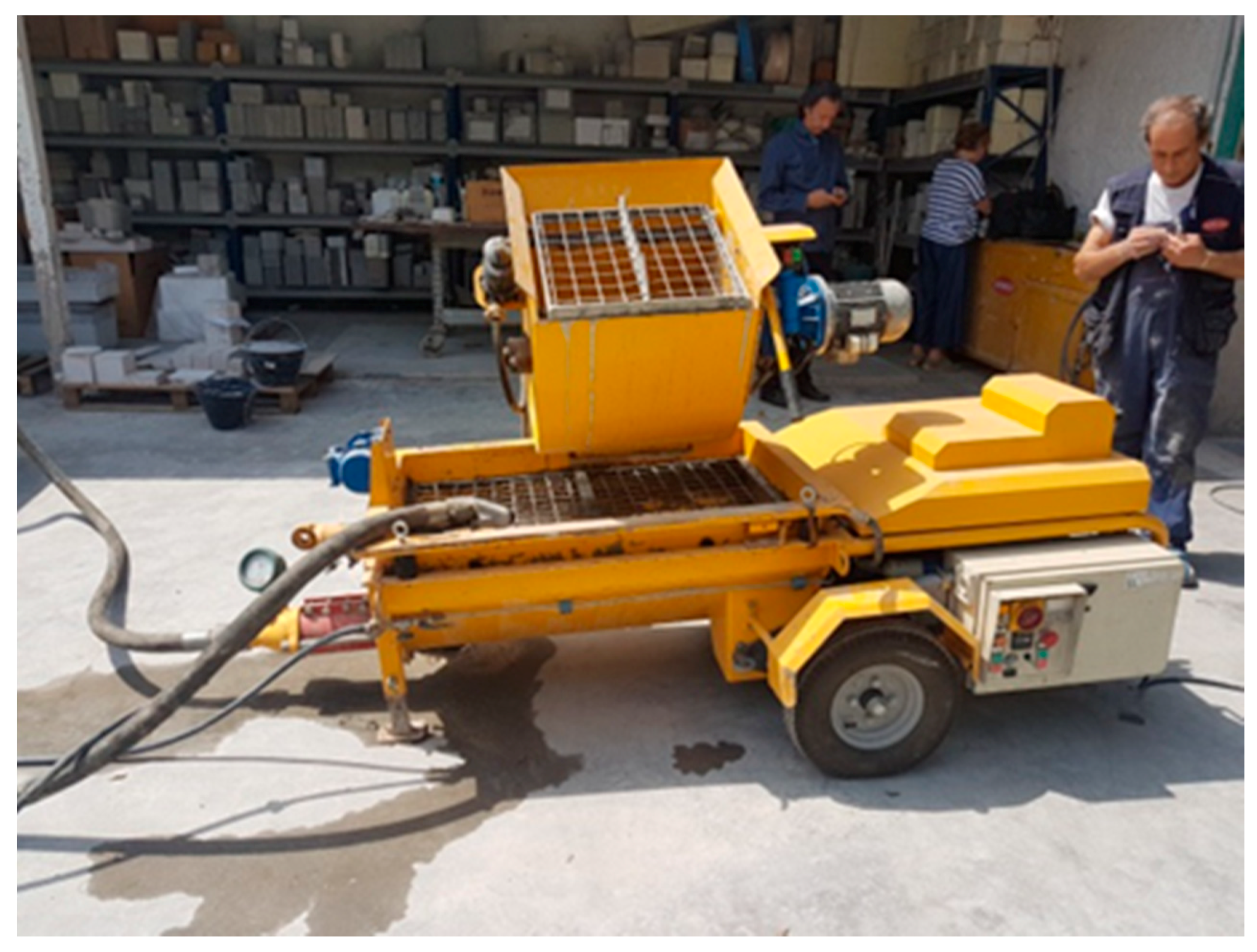
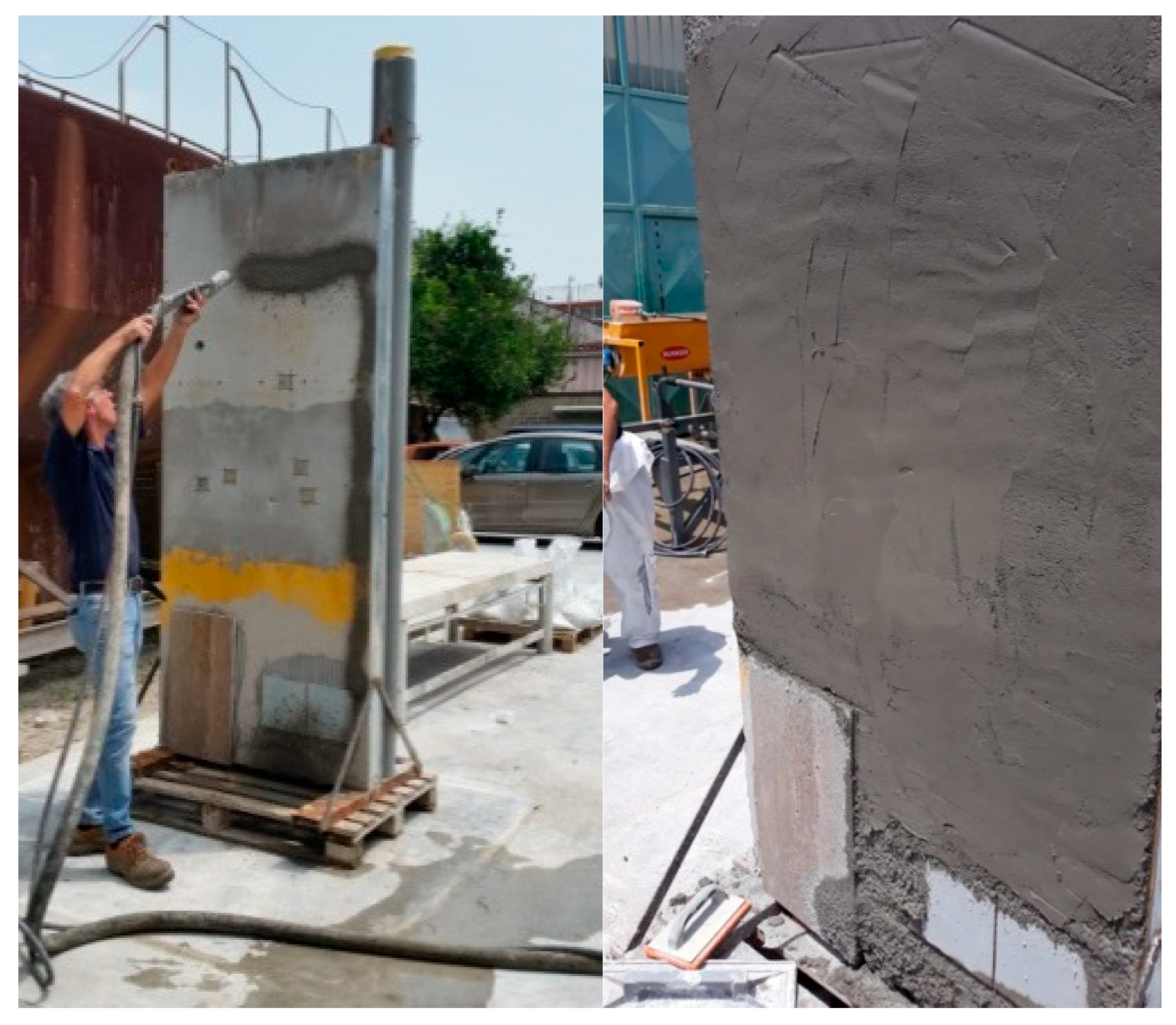
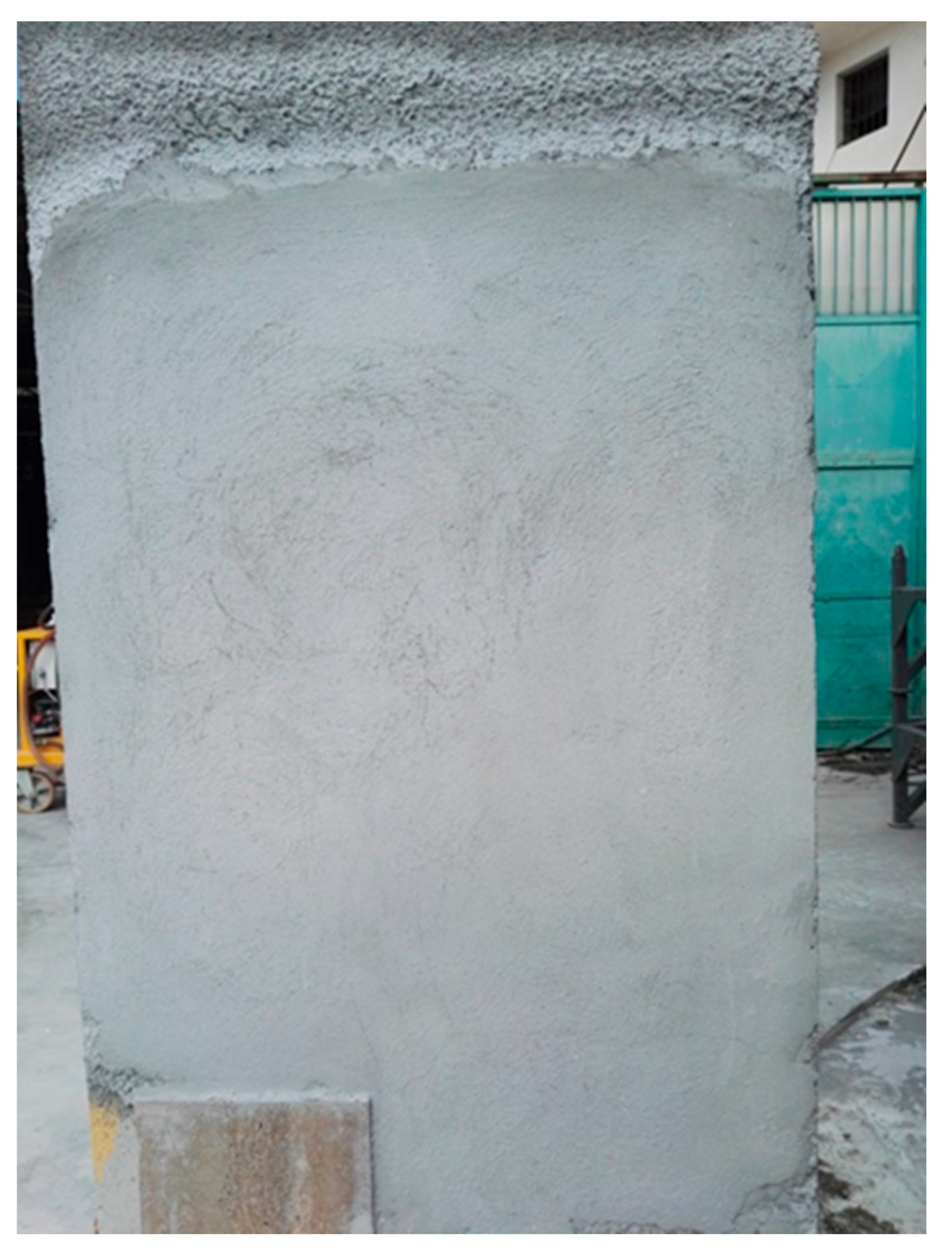
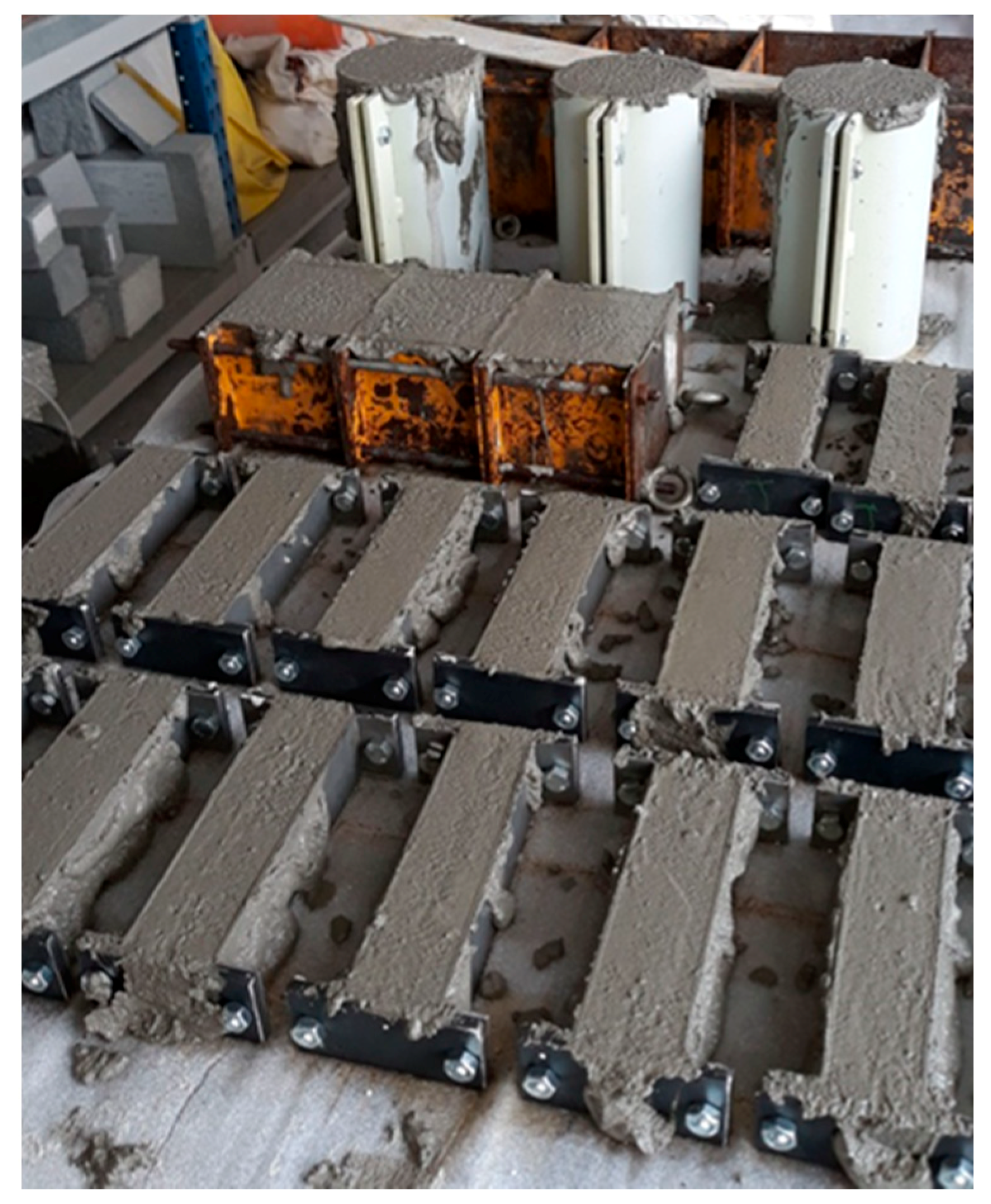
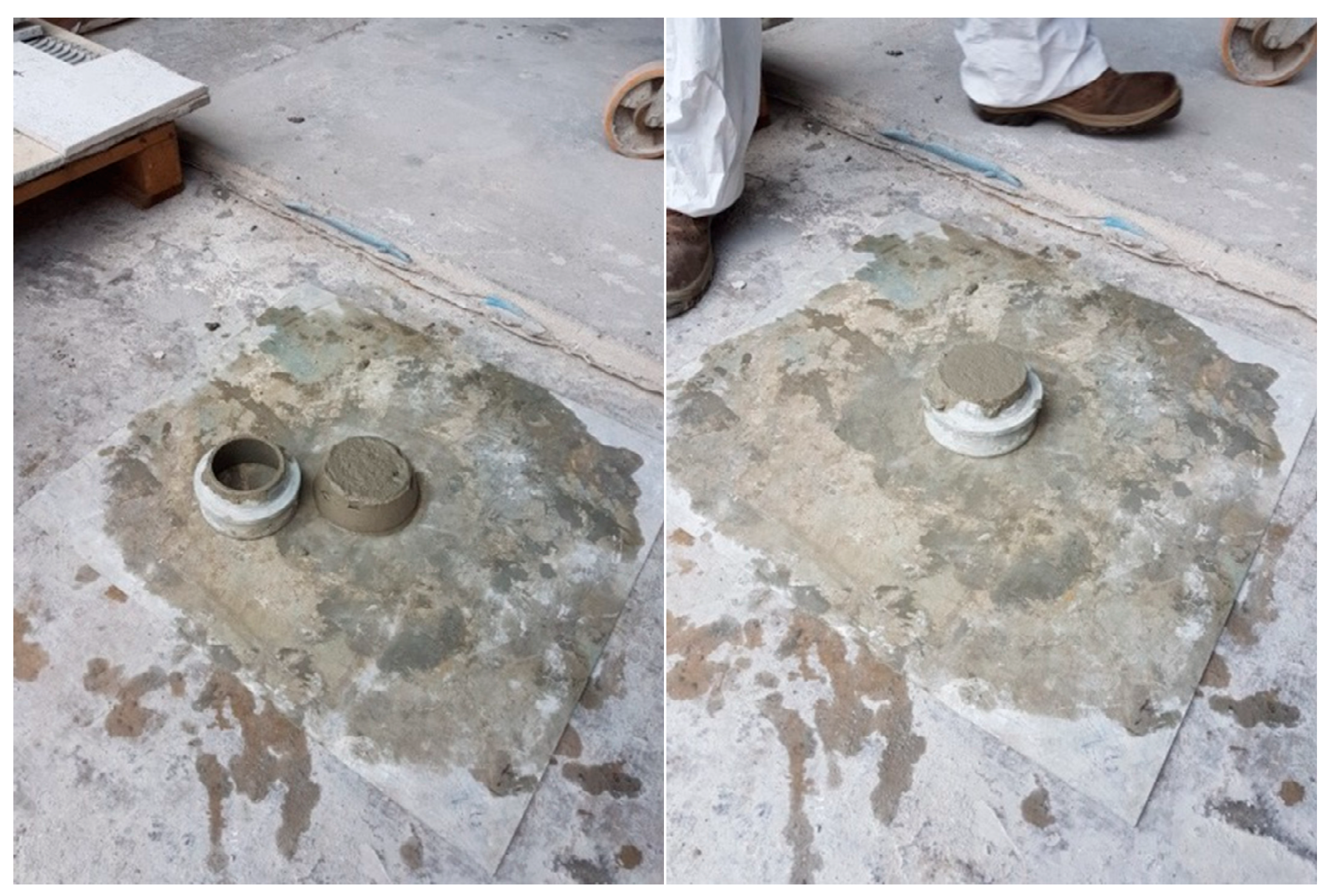
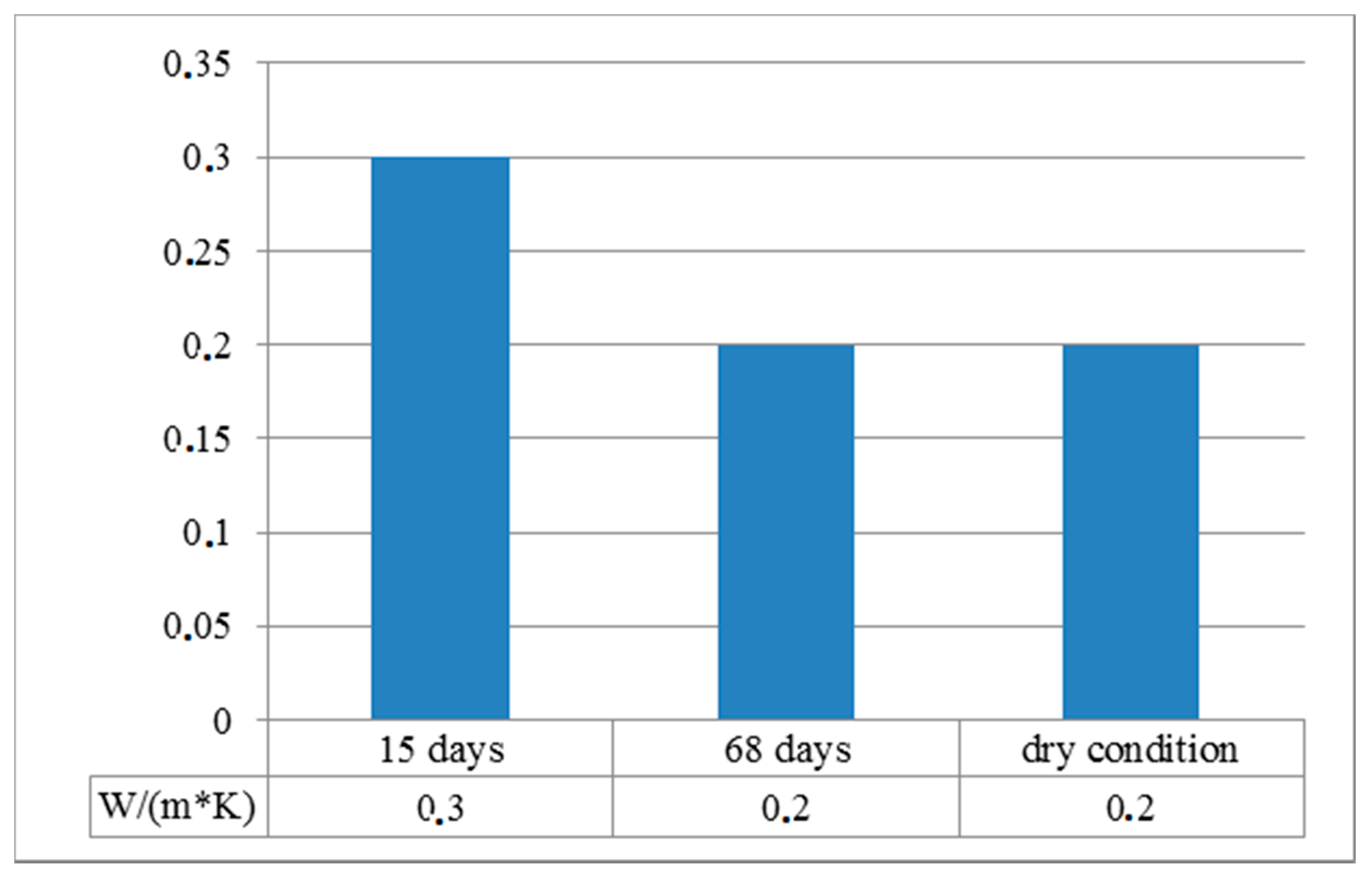
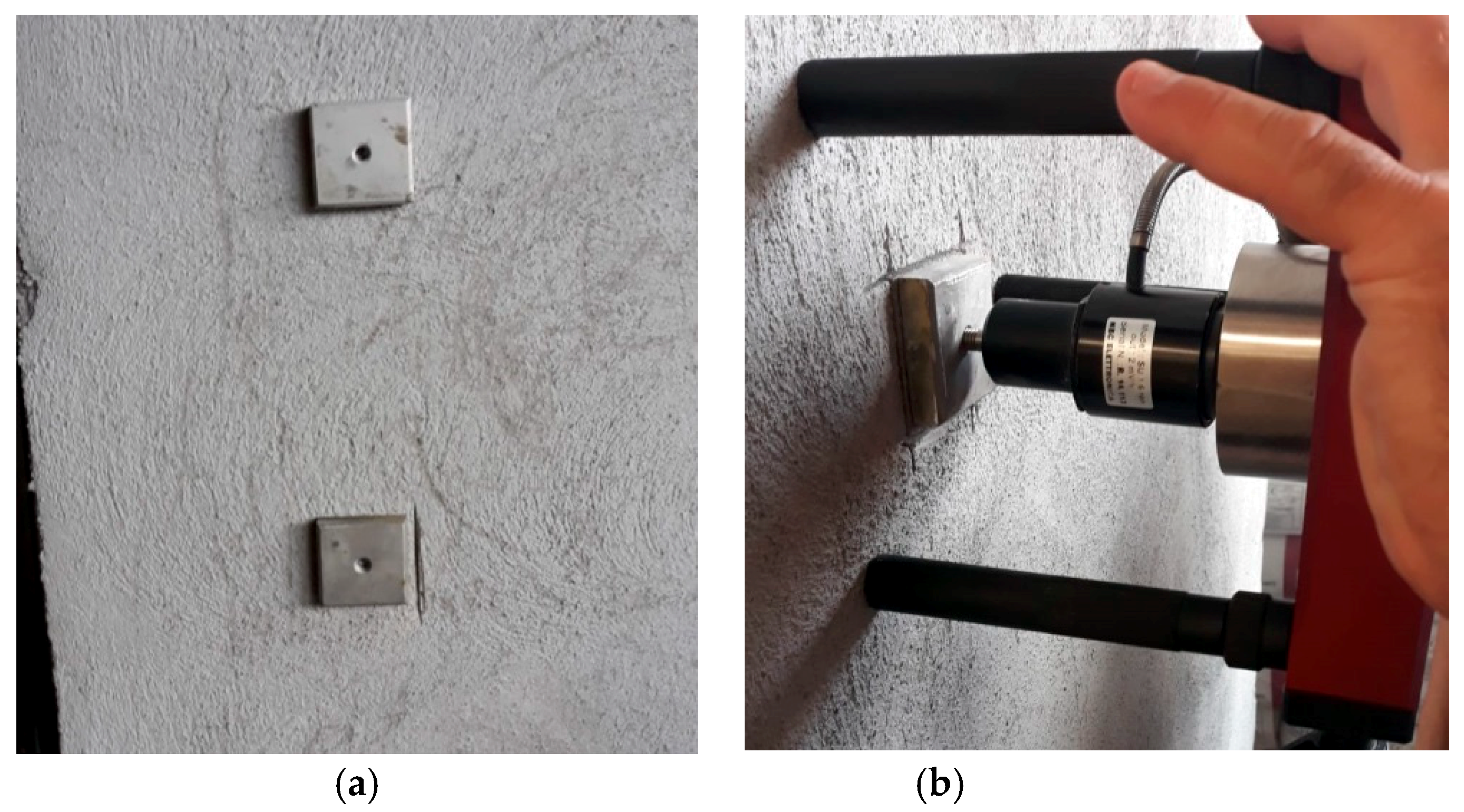
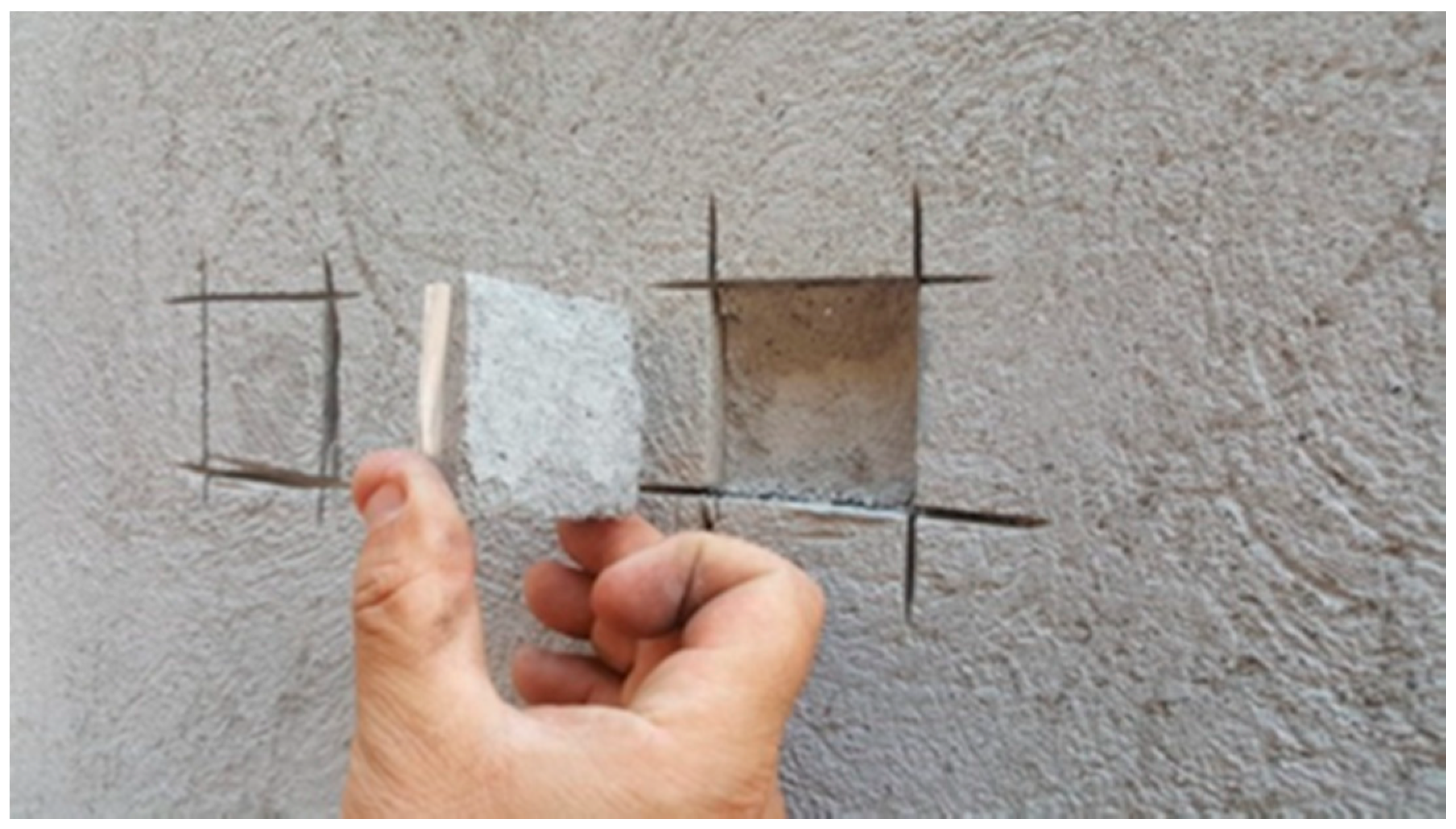
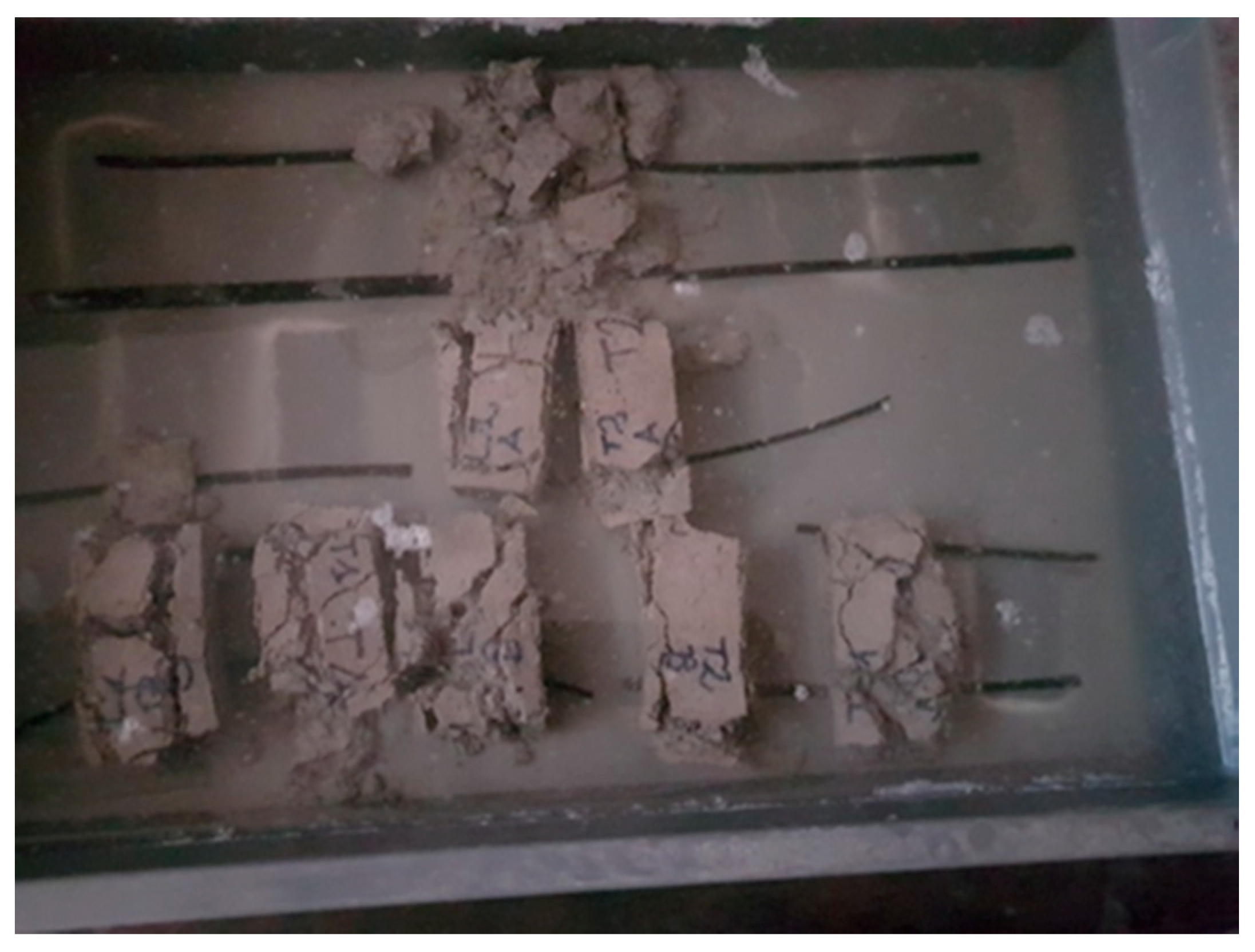
| Sample vs. Limits | Cu | Zn | Co | Ni | As | Cd | Total Cr | Cr VI | Pb | Hg | Fe |
|---|---|---|---|---|---|---|---|---|---|---|---|
| mg/kg | |||||||||||
| Luserna Sawing Sludge | 41.89 | 24.82 | 26.15 * | <0.01 | <0.1 | <0.1 | 18.21 | <5 * | 23 | <0.01 | 4340 |
| Concentration Limit Column A | 120 | 150 | 20 | 120 | 20 | 2 | 150 | 2 | 100 | 1 | / |
| Concentration Limit Column B | 600 | 1500 | 250 | 500 | 50 | 15 | 800 | 15 | 1000 | 5 | / |
| Sample vs. Limits | Ba | Cu | Zn | Be | Co | Ni | V | As | Cd | Total Cr | Pb | Se | Hg | NO3 | F | SO4 | Cl |
|---|---|---|---|---|---|---|---|---|---|---|---|---|---|---|---|---|---|
| mg/l | µg/l | mg/l | |||||||||||||||
| Luserna Sawing Sludge | 7.4 | <0.1 | <0.031 | <0.01 | <1 | <10 | <1 | <1 | <0.1 | <0.1 | <1 | <0.01 | <1 | <1 | <0.1 | 1.3 | 1.86 |
| Threshold Limit | 1 | 0.05 | 3 | 10 | 250 | 10 | 250 | 50 | 5 | 50 | 50 | 10 | 1 | 50 | 1.5 | 250 | 100 |
| Sample | Magnetic Fraction (%) | Amagnetic Fraction (%) |
|---|---|---|
| Luserna Sawing Sludge | 1.95 | 98.05 |
| Mix Design Components | M.U. | Quantities for 1 m3 |
|---|---|---|
| Portland Cement 42.5R | kg | 313 |
| Lime Natural Hydraulic Lime 3.5 | kg | 38 |
| Luserna Flaming Sand 0/3 mm | kg | 813 |
| Luserna Filler 0/0.1 mm (*) | kg | 187 |
| Micro Fibre (**) | kg | 0.3 |
| Natural Foam 72–75 g/m3 | m3 | 0.37–0.38 |
| Mix Design Components | M.U. | Quantities for 1 m3 |
|---|---|---|
| Portland Cement 42.5R | kg | 313 |
| Lime Natural Hydraulic Lime 3.5 | kg | 38 |
| Luserna Flaming Sand 0/3 mm | kg | 813 |
| Nola’s Tufo Powder | kg | 38 |
| Luserna Filler 0/0.1 mm | kg | 149 |
| Micro Fibre | kg | 0.3 |
| Natural Foam 72–75 g/m3 | m3 | 0.37–0.38 |
| Tests Carried out | Standard References | Number of Specimens | Specimens Size |
|---|---|---|---|
| Bulk Density of Fresh Mortar | EN 1015-6:2007 [27] | 1 | A cubic meter of fresh mortar |
| Dry Bulk Density | EN 1015-10:2007 [28] | 3 | 40 mm × 40 mm × 160 mm |
| Flexural and Compressive Strength | EN 1015-11:2007 [29] | 3 (flexural strength) 6 (compressive strength) | 40 mm × 40 mm × 160 mm (flexural strength) 40 mm × 40 mm × 80 mm (compressive strength) |
| Flexural and Compressive Strength after Freeze and Thaw Cycles | EN 12371:2010 [30] | 3 (flexural strength) 6 (compressive strength) | 40 mm × 40 mm × 160 mm (flexural strength) 40 mm × 40 mm × 80 mm (compressive strength) |
| Adhesive Strength–Pull Out | EN 1015-12:2016 [31] | 4 | n.d. |
| Compressive Strength Class | EN 998-2:2016 [32] | 6 | 40 mm × 40 mm × 80 mm |
| Compressive Strength Category | EN 998-1:2016 [33] | 6 | 40 mm × 40 mm × 80 mm |
| Spreading Test | ASTM D 6103:2017 [34] | 3 | Cone |
| Water Absorption | EN 13755:2008 [35] | 12 | 40 mm × 40 mm × 160 mm |
| Thermal Conductivity at 15 and 68 Days of Curing | EN 1745:2012 [36] | 3 | Diameter 100 mm, height 200 mm |
| Thermal Conductivity in Dry Condition | EN 1745:2012 [36] | 3 | Diameter 100 mm, height 200 mm |
| Resistance to Salts Crystallisation | EN 12370:2001 [37] | 4 | 40 mm × 40 mm × 160 mm |
| Chemical Analysis and Leaching Test | D.Lgs. 152/2006 Annex 5, Part IV and Art. 8 of D.M. 05/02/1998. [19] | 1 | n.d. |
| Tests Carried out | Plaster |
|---|---|
| Fresh Condition–Density (kg/m3) | 1380 |
| Dry Condition–Density (kg/m3) | 1264 |
| Fresh Condition–Slump Test-Hargerman Cone Diameter: 100 mm | No evident slump |
| Thermal Conductivity-15 days (W/m·K) | 0.302 |
| Thermal Conductivity-68 days (W/m·K) | 0.204 |
| Thermal Conductivity–Dry Condition (W/m·K) | 0.201 |
| Water Absorption before Freeze and Thaw Cycle (%) | 20 |
| Water Absorption after Freeze and Thaw Cycle (%) | 19 |
| Tests Carried out | Plaster |
|---|---|
| Pull off (MPa) | 1.55 |
| Compressive Strength (MPa) | 11.97 |
| Compressive Strength after Freeze and Thaw (MPa) | 10.76 |
| Compressive Strength Class (UNI EN998-2) | M10 |
| Compressive Strength Category (UNI EN 998-1) | CS IV |
| Flexural Strength (MPa) | 1.03 |
| Flexural Strength after Freeze and Thaw (MPa) | 0.93 |
| Sample | Md (g) | Mf (g) | ΔM (%) | Average Value (%) |
|---|---|---|---|---|
| L1 | 324.09 | 313.86 | −3.16 | −3.56 |
| L2 | 351.09 | 337.2 | −3.96 | |
| T1 | 354.61 | 339.81 | −4.17 | −4.06 |
| T2 | 355.8 | 341.72 | −3.96 |
| Samples | Flexural Strength (MPa) |
|---|---|
| L1 and L2 | 1.36 |
| T1 and T2 | 1.99 |
| Sample vs. Limit | Fe | Cu | Zn | Co | Ni | As | Cd | Cr | Pb | Cr VI | Hg |
|---|---|---|---|---|---|---|---|---|---|---|---|
| mg/kg | |||||||||||
| Plaster | 7861 | 41 | 91 | 5 | 13 | 6 | <1 | 15 | 10 | <5 | <5 |
| Limit column B | / | 600 | 1500 | 250 | 500 | 50 | 15 | 800 | 1000 | 15 | 5 |
| Sample vs. Limit | Fe | Ba | Cu | Zn | Co | Ni | V | As | Cd | Cr | Pb | Be | Hg | Se |
|---|---|---|---|---|---|---|---|---|---|---|---|---|---|---|
| mg/L | µg/L | mg/L | ||||||||||||
| Plaster | 0.401 | 0.02 | 0.019 | <0.01 | <0.005 | <0.005 | <0.005 | <0.01 | <0.001 | 0.075 | <0.01 | <0.001 | <0.0005 | <0.025 |
| Limits | / | 1 | 0.05 | 3 | 250 | 10 | 250 | 50 | 5 | 50 | 50 | 10 | 1 | 10 |
© 2020 by the authors. Licensee MDPI, Basel, Switzerland. This article is an open access article distributed under the terms and conditions of the Creative Commons Attribution (CC BY) license (http://creativecommons.org/licenses/by/4.0/).
Share and Cite
Zichella, L.; Marone, P.; Buonanno, P.; D’Amore, M.; Bellopede, R. Silicate Sawing Sludge Recovery in Thermo Eco-Mortar for Macroporous Plaster. Materials 2020, 13, 1293. https://doi.org/10.3390/ma13061293
Zichella L, Marone P, Buonanno P, D’Amore M, Bellopede R. Silicate Sawing Sludge Recovery in Thermo Eco-Mortar for Macroporous Plaster. Materials. 2020; 13(6):1293. https://doi.org/10.3390/ma13061293
Chicago/Turabian StyleZichella, Lorena, Paolo Marone, Pasquale Buonanno, Marco D’Amore, and Rossana Bellopede. 2020. "Silicate Sawing Sludge Recovery in Thermo Eco-Mortar for Macroporous Plaster" Materials 13, no. 6: 1293. https://doi.org/10.3390/ma13061293
APA StyleZichella, L., Marone, P., Buonanno, P., D’Amore, M., & Bellopede, R. (2020). Silicate Sawing Sludge Recovery in Thermo Eco-Mortar for Macroporous Plaster. Materials, 13(6), 1293. https://doi.org/10.3390/ma13061293







